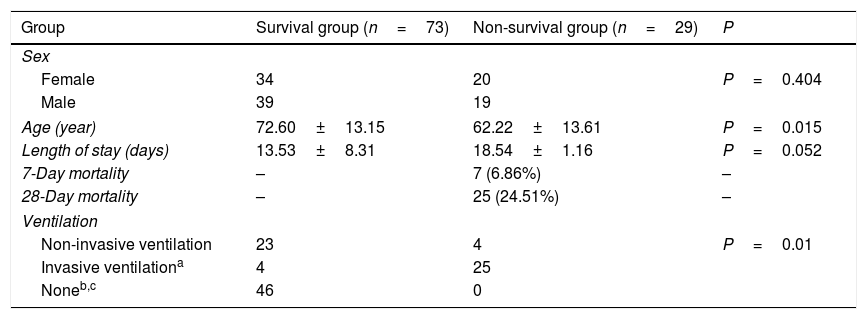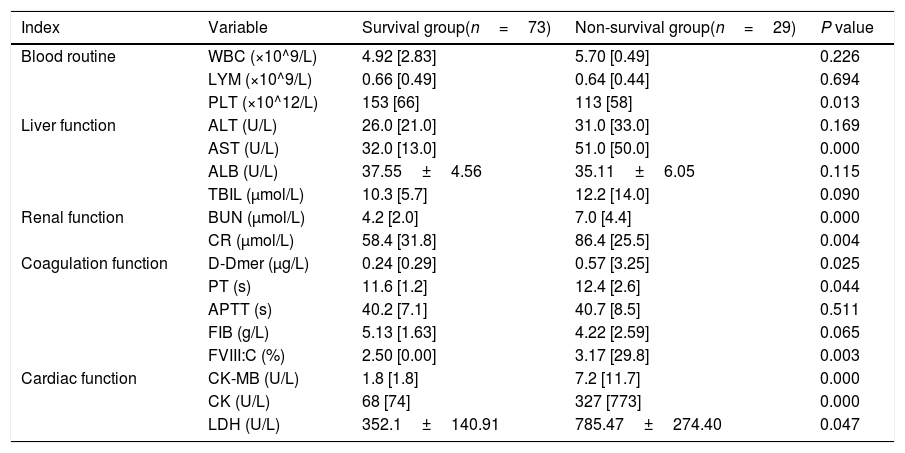The purpose of our study was to assess organ function in 102 patients with severe COVID-19 infections, using retrospective clinical analysis.
Material and methodsA retrospective analysis was conducted on 102 patients with severe COVID-19 infections. The patients were divided into a survival group (n=73) and a non-survival group (n=29) according to their prognosis. The age, sex, underlying diseases, clinical laboratory data within 48h (routine blood tests, ALT, AST, TBIL, ALB, BUN, CR, D-Dimer, PT, APTT, FIB, F VIII:C, CK-MB, CK, and LDH), and ventilation status were collected. The organ functions of these severe COVID-19 patients were assessed by comparing the differences between the two groups.
ResultsAST, BUN, CR, CK-MB, LDH, and CK in the non-survival group were higher than those in the survival group, and the differences were statistically significant (P<0.05). D-Dimer, PT, FIB, and F VIII:C in the non-survival group were higher than the values observed in the survival group, and the differences were statistically significant (P<0.05). PLT, AST, BUN, CR, D-Dimer, PT, FIB, F VIII:C, CK-MB, CK, and LDH predicted the area under the ROC curve (AUC) of the COVID19 endpoint events and were 0.721, 0.854, 0.867, 0.757, 0.699, 0.679, 0.715, 0.811, 0.935, and 0.802, respectively.
ConclusionThe results showed that there were different degrees of damage to the liver, kidneys, blood coagulation, and heart function in the non-survival group. In addition, PLT, AST, BUN, CR, D-Dimer, PT, FIB, F VIII:C, CK-MB, CK, and LDH had value in evaluating disease prognosis.
Nuestro estudio tiene como objetivo evaluar la función del órgano en 102 pacientes con infección grave COVID-19 mediante análisis clínicos retrospectivos.
Materiales y métodosAnálisis retrospectivo de 102 pacientes con infección grave COVID-19. Los pacientes se dividieron en grupo de supervivencia (n=73) y grupo de no supervivencia (n=29) según la pre-fase. Edad, género, enfermedades subyacentes, datos de laboratorio clínico dentro de las 48h (prueba de sangre de rutina, ALT, AST, TBIL, ALB, BUN, CR, dímero D, PT, APTT, FIB, F VIII: C, CK-MB, CK y LDH), y el estado de ventilación. Al comparar las diferencias entre los 2 grupos, se evaluó la función orgánica de estos pacientes graves con COVID-19.
ResultadosAST, BUN, CR, CK-MB, LDH y CK fueron todos más altos que el grupo de supervivencia en el grupo no sobreviviente, con una diferencia estadísticamente significativa (p<0,05). Dímero D, PT, FIB y F VIII: C fueron mayores que el grupo de supervivencia en el grupo de no supervivencia, y la diferencia fue estadísticamente significativa (p<0,05). PLT, AST, BUN, CR, dímero D, PT, FIB, F VIII: C, CK-MB, CK y LDH predijeron el área de curva inferior ROC (AUC) del evento final COVID-19, a 0,721, 0,854, 0,867, 0,757, 0,699, 0,679, 0,715, 0,811, 0,935 y 0,802, respectivamente.
ConclusiónLos resultados mostraron que el grupo de no supervivencia tenía diferentes grados de daño al hígado, riñón, coagulación y función cardíaca. Además, PLT, AST, BUN, CR, dímero D, PT, FIB, F VIII:C, CK-MB, CK y LDH tienen valor en la evaluación del pronóstico de la enfermedad.










